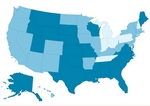business
1 in 9 jobs supported by hospitals, AHA says
■ The American Hospital Assn. and state hospital groups are releasing data as part of an effort to argue against cuts to Medicare and Medicaid reimbursements.
By Victoria Stagg Elliott — Posted July 5, 2010
- WITH THIS STORY:
- » External links
- » Related content
Hospitals are quantifying how much they contribute to the economy -- and how much they're being adversely affected by it -- to argue against cuts to the various government programs that support them.
"While the primary function of hospitals is providing care for millions of people, we are also providing an economic benefit to the community," said Elizabeth Baskett, the American Hospital Assn.'s associate director of policy.
On June 21, the AHA released its "Economic Contribution of Hospitals" report. The AHA said the health care sector, of which hospital care is the largest component, added $2.3 trillion to the U.S. economy in 2008, or 16.2% of gross domestic product. Hospitals accounted for $718 billion of that total; employed more than 5.3 million people, including physicians; and spent about $320 billion on goods and services from other industries, according to AHA data. The Bureau of Labor Statistics puts hospital employment figures at 4.7 million nationally as of May 2010.
Overall, hospitals support one in nine jobs in the U.S., according to the AHA report, based on a multiplier established at 2.8 jobs for every hospital job created. The calculation includes additional jobs in the community that are aided by the purchasing power of hospitals and their employees.
Before the report's release, the AHA, along with the Assn. of American Medical Colleges, the Catholic Health Assn. of the United States and the Federation of American Hospitals, on June 18 sent a letter to the Senate expressing support for action to fix the Medicare sustainable growth rate formula for physician payment, but not at the expense of hospitals. The letter argued against preventing hospitals from re-filing underpaid claims, because the Congressional Budget Office has estimated a ban on re-filing would cost hospitals $4 billion.
The 2.2% Medicare pay increase for physicians through November, signed June 25 by President Obama, did not include removing the language that prevents hospitals from re-filing claims.
Reports about the economic state of the hospital industry also are being issued at the state level, although these studies are independent of each other and from the national report from the AHA.
The Michigan Health & Hospital Assn. released a report in March in conjunction with the Michigan State Medical Society and the Michigan Osteopathic Assn. that found that 526,700 jobs in the state during the 2008 fiscal year were in the health care setting. Another 388,200 were indirectly connected to the industry. The report has been issued annually for the past five years.
"Hospitals are really an economic engine for the state at a time when we are in desperate need of one," said Brian Peters, executive vice president of operations for the Michigan hospital association. "And if there is legislation that is detrimental to the health care sector, we may not only be jeopardizing access to health care but jeopardizing the state's economic growth as well."
Another report, "Pennsylvania Hospitals Strengthen Pennsylvania's Economy," released in March by the Hospital & Healthsystem Assn. of Pennsylvania, found that hospitals contributed $89.8 billion to the state's economy in 2008. Approximately 596,000 people were employed in the industry.
"Hospitals are major employers that offer jobs with above-average salaries and benefits," said Martin Ciccocioppo, vice president of research for the Pennsylvania organization.
Experts suspect that, although the health sector has not been unscathed in the recent recession, it will continue to grow. The growth, however, may be muted. An AHA report, also released in June, documented the continuing impact of the recent recession and cuts to various public programs. Approximately 67% of hospitals executives surveyed in March and April of this year said their institutions were caring for more people insured through Medicaid, CHIP or other public programs. In addition, 74% of hospitals were experiencing reduced operating margins. Approximately, 53% reduced staff, and 89% had yet to hire workers back or increase hours that had been cut.
"The economy is turning around, and we see improvements in all different sectors," the AHA's Baskett said. "But hospitals are still feeling the impact of the recession."












